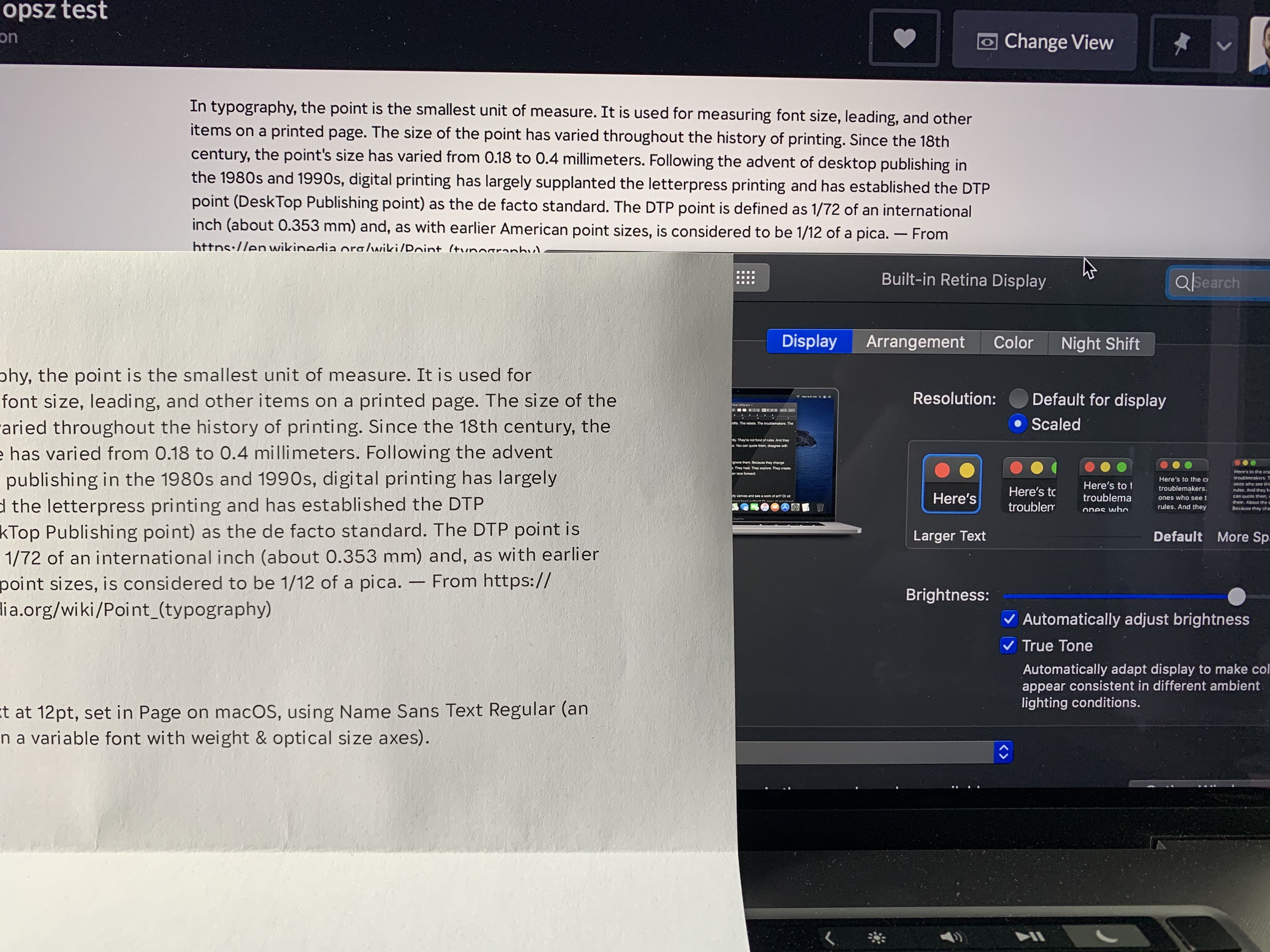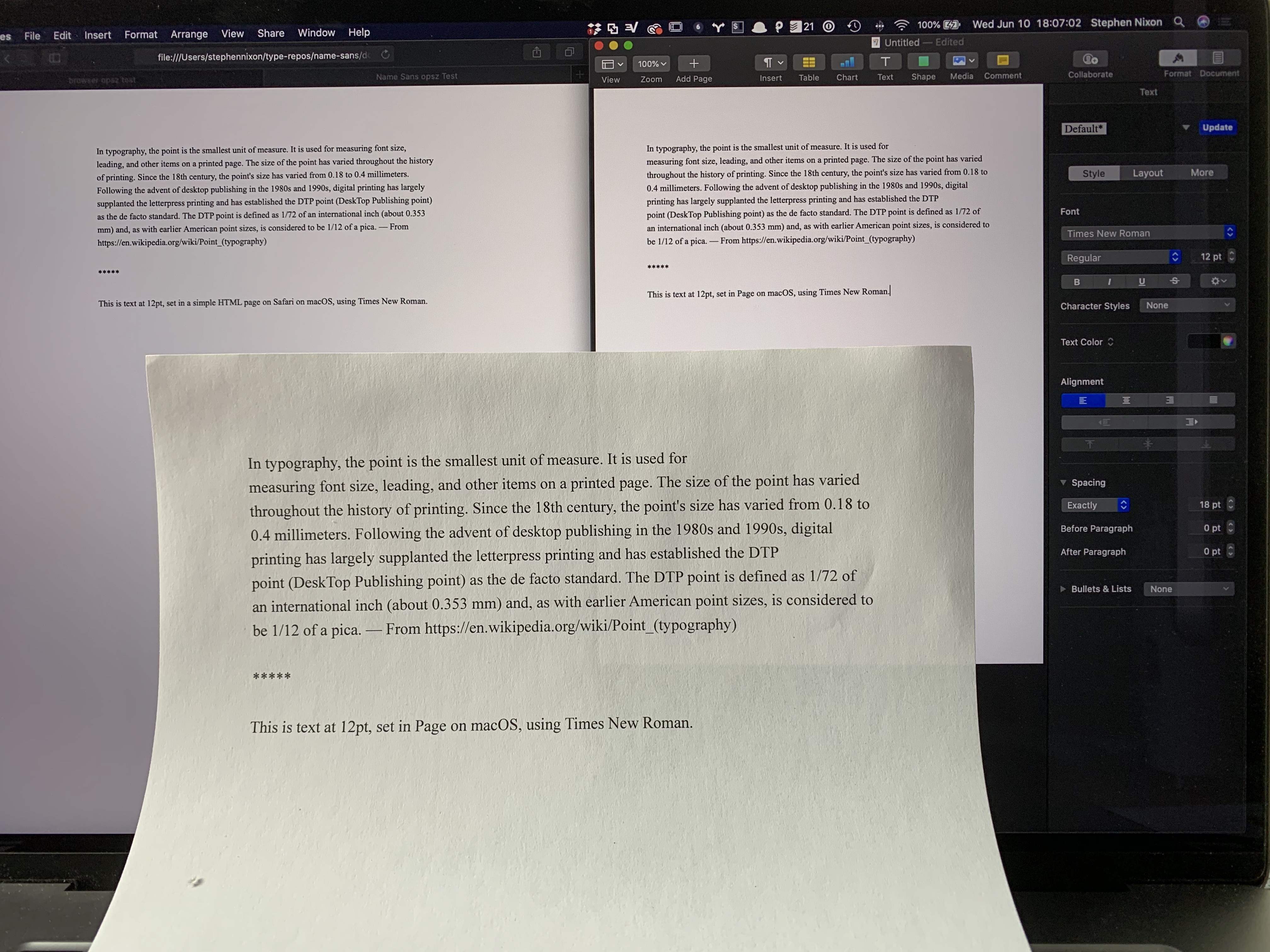Perhaps I should say 'quantization' rather than 'rasterization' as the point is that the glyph outline design (what I just called the '1000 UPM grid') is resolved to a 'css px' grid, that has a varying "resolution", and that grid, not a physical size, is what MUST be targeted - because the actual physical size has been abstracted away, along with ppem raster sizes and real pixels.
And yet it isn't really abstracted away, because there is an actual physical size to a piece of text that is displayed to a reader. There may be difficulties in determining what that size is going to be from an upstream perspective, given the variety of devices, platforms, libraries involved, and there may even be difficulties in determining what that size is, given the variety of resolutions involved. But the text is an actual, physical size, which is what the optics of the reader is seeing, and which optical size is supposed to address. If it really can't address that physical size any more, maybe the thing to do — given all those givens — is to throw out the concept of optical size as it is currently understood by type designers and typographers, to throw out all the analogues to size-specific metal fonts, and to instead embrace a more vague, less size-specific concept of 'size tuning' of design: smallest, smaller, small, smallish.... That suggests the possibility of a properly abstracted ‘size’ axis scale like that we have for wght, in which CSS might define what big round number equals 'Smallest' then 'Smaller' etc.. Then we could stop worrying about points and pixels, and just avar map our design spaces to the abstract scale.
The opsz scale HAS ALREADY been redefined to use 'px' as a unit.
What we disagree about, I think, is the implication of that decision. It isn't just a change to a different unit, but from an absolute, physical unit to an uncertain flexi-unit. Redefining the opsz scale to use px as a unit means redefining it as not optical. Yes, we can say that Mac OS is the oddity in the way it makes a kind of px and a kind of pt equivalent, and hence the size of px on that platform vs other platforms, but I'm not left with any reassurance that it is the only oddity or will remain the only oddity. Once you have a flexi-unit, you really can't make any assumptions or predictions.




Introduction
This proposal extends the CSS Fonts Module Level 4
font-optical-sizingproperty by allowing numerical values to express the ratio of CSSpxunits to the the units used in theopszOpenType Font Variation axis. The ratio is intended to be multiplied byfont-size, measured inpx, allowing control over the automatic selection of particular optical size designs in variable fonts.The proposal resolves the conflicting implementations of the
font-optical-sizing: autobehaviour, and provides additional benefits for font makers, CSS authors, and end-users.Examples
font-optical-sizing: 1.0;current Apple Safari behaviour where 1px = 1 opsz unitfont-optical-sizing: 0.75;Apple TrueType and OpenType behaviour where 1px = 0.75 opsz units (1px = 0.75pt in many user agents)font-optical-sizing: 0.5;custom behaviour where 2px = 1 opsz unit, to “beef up” the text (e.g. in an accessibility mode for visually impaired end-users)font-optical-sizing: 2.0;custom behaviour where 1px = 2 opsz units, to reduce the “beefiness” of the text (suitable for large devices)font-optical-sizing: auto;use thefont-optical-sizingratio defined in the user agent stylesheetBackground
OpenType Font Variations in CSS
When the OpenType Font Variations extension of the OpenType spec was being developed in 2015–2016, Adam Twardoch and Behdad Esfahbod proposed the addition of the low-level
font-variation-settingsproperty to the CSS Fonts Module Level 4 specification, modeled afterfont-feature-settings.For higher-level control of font variations, there was general consensus that the
font-weightproperty would be tied to thewghtfont axis registered in the OpenType specification,font-stretchwould be tied towdth, whilefont-stylewould be tied toitalandslnt.OpenType opsz variation axis and CSS font-size
The consensus was that the CSS
font-sizeproperty could be tied to the axis registered for optical size,opsz. Theopszaxis provides different designs for different sizes. Commonly, a lower value on theopszaxis yields a design that has wider glyphs and spacing, thicker horizontal strokes and taller x-height. The OpenType spec suggests that “applications may choose to select an optical-size variant automatically based on the text size”, and states: “The scale for the Optical size axis is text size in points”. Apple’s TrueType Variations specification (on which OpenType Font Variations is based) also mentions point size as the scale for interpreting theopszaxis: “'opsz', Optical Size, Specifies the optical point size.” It is notable that neither the OpenType spec nor Apple’s TrueType spec addresses the interpretation ofopszvalues in environments where the typographic point is not usefully defined.Optical sizing introduces a new factor in handling text boxes in web documents. If the font size of a text box changes, the proportions of the box not remain constant because of the non-linear scaling of the font; typically the width grows at a slower rate than the height, because of the optical compensations in typeface design mentioned above. Realizing that many web documents may rely on the assumption of linear scaling, Twardoch proposed an additional CSS property
font-optical-sizing:auto: “enables” optical sizing by tying the selection of a value on theopszaxis to the font size changenone: “disables” optical sizing by untying that selection, so font size change happens linearlyThe
font-optical-sizingproperty is currently part of CSS Fonts Module Level 4 working draft.Controversy: opsz axis and CSS font-size (px vs. pt)
Unfortunately recent browser developments introduced ambiguity in terms of how
opszvalues should be interpreted:~Most browser implementers interpret
opszas expressed in CSSptunits (points). If optical sizing is enabled, all text has itsopszaxis set to the value of the font size inpt.~ [In fact, Chrome and Firefox, as well as Safari, interpretopszinpxunits. Updated thanks to @drott’s comment below.]Apple in Safari has decided to interpret
opszas expressed in CSSpxunits (pixels). If optical sizing is enabled, all text has itsopszaxis set to the value of the font size inpx.Font makers and typographers are upset at Apple’s decision. They design fonts with the assumption that
opszis expressed in points. Sincepxvalues are commonly higher thanptvalues (typically at a ratio of 4:3) interpretingopszinpxmeans the that a higher optical size will be chosen than intended. For 9pt/12px text, theopszdesign12will be chosen, which will yield text that is too thin, too tightly spaced, and potentially illegible. They argue that the user experience will degrade, and optical sizing will actually yield worse results than no optical sizing, effectively defeating the whole purpose and unjustly giving variable fonts bad reputation. Inconsistent behaviour with the same font will cause problems for font makers and CSS authors.Apple defends this decision, suggesting that CSS authors can simply set
font-variation-settings: 'opsz' n.CSS authors object that using
font-variation-settingsbreaks the cascade for font styling and, because of the nature of optical size, is unsuitable for application at the document root level. Therefore it will not get used.Proposed resolution: numerical values in font-optical-sizing
The CSS
font-optical-sizingproperty currently controls the relationship betweenfont-sizeandopszby means of a simple switch (auto/none). We propose to allow a numeric value forfont-optical-sizing. This value expresses the ratio ofopszunits to CSSpx. Examples:font-optical-sizing: 1.0;current Apple Safari behaviour where 1px = 1 opsz unitfont-optical-sizing: 0.75;Apple TrueType and OpenType behaviour where 1px = 0.75 opsz units (1px = 0.75pt in many user agents)font-optical-sizing: 0.5;custom behaviour where 2px = 1 opsz unit, which would “beef up” the text (suitable for very small devices)font-optical-sizing: 2.0;custom behaviour where 1px = 2 opsz unit, which would “reduce the beefiness” of the text (suitable for large devices)font-optical-sizing: auto;use thefont-optical-sizingratio defined in the user agent stylesheetResults
User agents can ship with default
font-optical-sizingother than 1.0. (The CSS specification might recommend 0.75 as a reasonable default for most situations.)Font makers can ship a single font whose
opszaxis works as intended in browsers as well as print.CSS authors can change the value whenever they like, independently of the choices made by browser vendors and font makers.
CSS authors can specify a different
font-optical-sizingratio for different media queries, including print, or for aesthetic purposes.End-users can be offered accessibility modes that choose low values for
font-optical-sizingto ensure lower-than-defaultopszvalues and more legible text.Note
Proposers